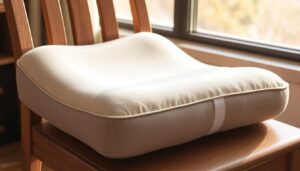New parents often struggle to juggle work and baby care. This can lead to back pain. Being a mom who multitasks can be very hard. It affects both your personal and work life.
Finding a balance between parenting and work is key. This guide will share tips and strategies. They help manage work and baby care, reducing back pain and improving your health.
Key Takeaways
- Effective time management techniques for balancing work and baby care
- Strategies for reducing back pain during pregnancy and postpartum
- Tips for maintaining a healthy work-life balance as a new parent
- Simple exercises to strengthen back muscles and prevent pain
- Practical advice for managing stress and anxiety as a new mom
The Double Burden: Understanding the Physical Toll of Parenthood and Career
Being a parent and working can really hurt your body. It can mess with your posture, strength, and health. Parents try to do both jobs well but face many physical challenges.
Common Physical Challenges for Working Parents
Working parents have to lift and carry their babies. They also sit for long times at work. These things can hurt their backs, shoulders, and more.
Identifying Pain Points in Your Daily Routine
To lessen the physical strain, find out what hurts in your daily life. Pay attention to how you lift your baby and sit at your desk. Also, think about how you handle your work.
How Sleep Deprivation Affects Posture and Pain
New parents often don’t get enough sleep. This can hurt your posture and cause pain. Not sleeping well makes you tired, leading to bad posture and back pain.
Knowing these issues and making changes can help working parents stay healthy. They should focus on good posture care and use work-baby ergonomics in their daily lives.
The Science Behind Parenting-Related Back Pain
Back pain from parenting comes from many factors. The hard work of caring for a baby and changes in the body during and after pregnancy affect parents a lot. These changes can really hurt a new parent’s life.

Anatomical Changes During and After Pregnancy
Pregnancy changes the body a lot to fit the growing baby. These changes can hurt the back. Core muscle weakness often happens because of these changes.
Core Muscle Weakness and Its Impact
The core muscles help keep the spine strong and posture good. When they get weak, posture can suffer. This can hurt the back. Doing posture care and exercises can help.
Hormonal Effects on Joint Stability
Hormones in pregnancy can make joints unstable. The hormone relaxin makes ligaments loose for childbirth. But it can also make joints move too much, hurting the lower back.
Knowing about these changes is key for new parents to keep their back healthy. They can stay aware of the challenges. This way, they can keep good posture, do the right exercises, and use smart mom multitasking to avoid back pain.
Creating an Ergonomic Home Office for New Parents
Working from home with a baby needs a special office setup. It must support your back with ergonomic design. This helps new parents work comfortably and effectively.
Essential Equipment for Back-Friendly Remote Work
Getting the right gear is key for a good home office. A good chair and desk are the foundation of a back-friendly workspace.
Selecting the Right Chair and Desk Height
Choose a chair that adjusts in height and has lumbar support. Your desk should let you work with elbows at 90 degrees. Consider a sit-stand desk to switch between sitting and standing.
Monitor Positioning for Nursing Parents
Right monitor placement is important for neck and back health. Place your monitor 20-25 inches away and slightly below eye level. This is great for nursing parents to stay comfy while caring for their baby.
Using these ergonomic tips in your home office can lower back pain risk. It also boosts your health as a new parent working from home.
Baby Care Ergonomics: Lifting and Carrying Techniques
Being a new parent is tough. It’s key to keep your back safe while lifting your baby. Using the right lifting ways is important to avoid hurting yourself.
Proper Lifting Mechanics to Protect Your Back
Lifting a baby can hurt your back if you do it wrong. Use your legs, not your back, to lift.
Bending at the knees is the safe way to lift. This keeps the baby close and spreads the weight out. It makes lifting easier on your back.
The Squat-Lift Method for Cribs and Playpens
The squat-lift is great for getting a baby from a crib or playpen. Stand right next to the crib with your feet apart.
- Bend your knees to get down to the baby’s level.
- Keep your back straight and your core tight.
- Lift the baby gently, keeping them close.
- Stand up by pushing through your heels, using your legs.
Transitioning Baby Between Surfaces Safely
When moving a baby from one place to another, be careful. Avoid twisting or bending in a bad way.
Plan your move carefully. Stand close to both places. If needed, move a bit to avoid stretching.

Using these safe lifting tips can help prevent back pain from baby care. It’s all about being careful with how you move and lift.
Optimizing Your Baby’s Nursery to Prevent Strain
Choosing the right furniture heights in the nursery is key to lessening back pain. A good nursery is comfy for the baby and easy for parents to care for them without hurting their backs.
Crib and Changing Table Height Considerations
The crib and changing table’s height are very important. Setting these to a comfy height helps avoid back pain. This is a big help for new parents.
Measuring for Your Height and Reach
To find the best nursery furniture height, think about your own size. Measure from your waist to the floor first. The crib and changing table should be high enough so you don’t have to bend or stretch.
If your furniture can’t be changed, think about how to make it better. Adding risers or blocks under the legs can raise it. This small change can help a lot.
By making the nursery ergonomic, parents can avoid back pain. This is especially true when they’re balancing work and baby care. Making these changes can make parenting healthier and easier.
Time Management Strategies for Balancing Work and Baby
Managing work and baby care needs a good plan. As a new parent, it’s key to sort tasks well. This helps keep work and family life in balance.
Creating Realistic Schedules That Include Self-Care
It’s important to make a schedule that works. You need time for work, taking care of the baby, and taking care of yourself. Self-care boosts your health and work skills.
Block Scheduling for Physical Recovery
Block scheduling is great for new parents. It means setting aside big chunks of time for work, rest, and getting better physically. This helps handle the hard parts of parenting and working.
Integrating Movement Breaks Into Work Hours
It’s key to take breaks to move around at work. These breaks help avoid back pain and keep your posture right. Simple moves like stretching or short walks work well.
Studies show breaks help you work better and stay healthy. As one expert says,
“Regular movement is essential for maintaining physical health and reducing the risk of injury.”
| Task | Time Allocation | Benefits |
|---|---|---|
| Work | 8 hours | Professional productivity |
| Baby Care | 4 hours | Quality time with baby |
| Self-Care | 2 hours | Improved well-being |
Using these tips daily helps new parents manage time better and avoid back pain. Being flexible and changing plans as needed is also important.

Good time management is more than just planning. It’s also about keeping a good posture and being aware of your body’s needs. By planning well and taking care of your posture, new parents can find a good balance between work and family.
Strengthening Exercises for the Postpartum Body
Rebuilding core and pelvic floor strength is key for new parents. It helps them keep good posture, reduce back pain, and feel better overall. Adding strengthening exercises to their daily routine helps them manage work and baby care better.
Core Rehabilitation for New Parents
Core rehabilitation is very important after having a baby. It helps rebuild the strength and stability of the core muscles. This is crucial for lessening back pain and improving physical function.
Gentle Progression for Diastasis Recti Recovery
Gentle exercises help fix diastasis recti, a condition where the abdominal muscles separate during pregnancy. Start with:
- Deep breathing exercises to engage the diaphragm and promote core stability
- Gentle pelvic tilts to strengthen the lower back and pelvic floor muscles
- Progressive strengthening exercises to target the transverse abdominis muscle
Pelvic Floor Exercises During Work Breaks
Pelvic floor exercises, or Kegels, can be done during work breaks. They help strengthen the muscles that support the bladder, uterus, and bowels. To do a Kegel exercise:
- Contract the pelvic floor muscles as if stopping the flow of urine
- Hold for 5-10 seconds
- Release and repeat for 10-15 repetitions
By adding these exercises to their daily routine, new parents can boost their core strength. This helps reduce back pain and improves their overall health. It makes it easier to balance work and taking care of their baby.
Stretching Routines to Relieve Parenting-Related Tension
Working parents often feel a lot of physical tension. This is because they juggle work and taking care of their babies. Simple stretches can help ease this tension.
Desk-Based Stretches During Work Hours
Working parents can use desk stretches to feel better at work. These stretches help with posture care and reduce sitting strain.
Upper Back and Neck Relief Techniques
Try these stretches for your upper back and neck:
- Slowly tilt your head to the right, bringing your ear towards your shoulder.
- Gently roll your shoulders forward and backward in a circular motion.
- Place your hands behind your head and gently pull your head back, stretching your neck.
Wrist and Forearm Stretches for Computer Users
Computer users should try these wrist and forearm stretches:
- Hold your arm straight out in front of you and use your other hand to gently pull your hand back, stretching your wrist.
- Rotate your wrist in a circular motion, first clockwise and then counterclockwise.
Doing these stretches daily can help with the physical stress of mom multitasking. It makes work hours more comfortable.

| Stretching Routine | Benefits | Frequency |
|---|---|---|
| Neck Stretch | Relieves tension in the neck and upper back | 3 times a day |
| Wrist Extension Stretch | Reduces strain on the wrists and forearms | 2 times a day |
| Shoulder Rolls | Improves posture and reduces upper back tension | 5 times a day |
By adding these stretches to your day, working parents can handle their job better. It also improves their health and happiness.
Balancing Work and Baby: Creating Boundaries and Asking for Help
Working and taking care of a new baby is tough. You need to set boundaries and ask for help. This helps avoid burnout and back pain.
Communicating Needs to Employers and Partners
Talking clearly is important. New parents must tell their bosses and partners what they need. This means talking about work hours and who will watch the baby.
Negotiating Flexible Arrangements for Recovery
Flexible work is key for new parents. It helps during the time after having a baby. Employers who offer this help a lot to new parents’ health.
Setting Expectations About Physical Limitations
New parents should know their limits after having a baby. They should tell their bosses and partners about these limits. This way, they get the support they need.
By setting boundaries and asking for help, new parents can handle work and baby care better. This reduces back pain and improves their health.
Technology Tools and Apps for Working Parents
Working parents face many challenges. Technology can help a lot. It makes work easier and keeps you healthy.
Productivity Solutions That Allow for Movement Breaks
Technology helps parents move more. It lowers the chance of back pain. Apps remind you to stretch and move.
Time-Tracking Apps with Stretch Reminders
Apps like Toggl and Harvest help you remember to stretch. They keep you from sitting too long. This is good for your back.
Voice-to-Text Tools for Mobile Working
Voice-to-text tools let you work anywhere. You can dictate emails without bad posture. This keeps you healthy and productive.
| Tool/App | Feature | Benefit |
|---|---|---|
| Toggl | Time tracking with stretch reminders | Reduces prolonged sitting |
| Dragon NaturallySpeaking | Voice-to-text functionality | Promotes good posture care |
| Harvest | Time tracking with break reminders | Enhances productivity and reduces strain |
Technology helps working parents a lot. It makes work easier and keeps you healthy. Using these tools well can make you more productive and happy.
Mindfulness Practices for Pain Management and Stress Reduction
Working parents find mindfulness helpful. It helps them deal with the physical and emotional parts of being a new parent. Mindfulness makes it easier to balance work and taking care of a baby.
Brief Meditation Techniques for Busy Parents
Busy parents can use short meditation tricks. These tricks help lower stress and pain from parenting. They fit into a busy schedule.
One-Minute Breathing Exercises Between Tasks
Try one-minute breathing exercises between tasks. Focus on deep, slow breaths. This calms your mind and body.
To do it, sit right, breathe in deeply, hold it, then breathe out slowly. It’s simple but very helpful.
Mindful Transitions Between Work and Baby Care
Being mindful when switching between work and baby care helps too. It reduces stress. Just take a few deep breaths or notice your surroundings.
Or, think of something you’re thankful for. It’s a quick way to change your focus.
The table below shows easy mindfulness practices for busy parents:
| Mindfulness Practice | Benefit | Duration |
|---|---|---|
| One-Minute Breathing Exercises | Reduces stress and physical tension | 1 minute |
| Mindful Transitions | Improves focus and reduces stress | 1-2 minutes |
| Brief Meditation | Enhances mental clarity and reduces pain | 5-10 minutes |
By adding these mindfulness practices to their day, working parents can handle pain and stress better. This improves their well-being while they work and care for their baby.
When to Seek Professional Help for Persistent Pain
Many parents feel a lot of pain when they have a new baby and work too. It’s important to know when to get help. This helps keep everyone healthy.
Warning Signs That Require Medical Attention
Some pain is normal after having a baby. But, don’t ignore signs like very bad pain, numbness, or pain that goes down your legs or arms.
Differentiating Between Normal Fatigue and Injury
It’s hard to tell if you’re just tired or hurt. If pain lasts more than a few weeks or keeps you awake, see a doctor. Fatigue gets better with rest, but injury pain doesn’t.
Tracking Pain Patterns for Medical Consultations
Writing down when and where you feel pain helps. It tells doctors a lot. This way, you can tell them what makes your pain better or worse.
| Pain Characteristic | Description | Action |
|---|---|---|
| Location | Where is the pain located? | Note the specific area |
| Severity | Rate the pain from 1-10 | Track changes over time |
| Timing | When does the pain occur? | Identify patterns or triggers |
As Source2 and Source3 say, getting help for pain is key. Knowing when to ask for help keeps you and your baby safe.
“Pain is the body’s way of signaling that something is amiss. Ignoring persistent pain can lead to further complications and prolonged recovery times.”https://www.dictionary.com/browse/pain
Good posture is very important for posture care. Getting medical help and taking care of yourself helps you care for your baby better.
Success Stories: How Real Parents Maintain Back Health
Working parents can keep their backs healthy by using simple tips that fit their life. Looking at how other parents balance work and family, we learn how to take care of our backs.
A Remote Working Mother’s Approach
A remote working mom shows us how to make our home office work for our kids. She made ergonomic adjustments and set up a flexible workspace. This helped her do her job and take care of her family without hurting her back.
Adapting Home Office for Multiple Age Children
The remote working mom made her home office kid-friendly. She did this by:
- Setting up a safe space for her kids to play near her
- Getting a comfy, ergonomic chair and desk
- Using storage to keep things tidy
- Doing stretching exercises during work
- Doing exercises to strengthen her core
- Putting rest and self-care first
These steps helped her keep her back healthy, even with lots of kids.
These stories show us how to balance work and family by making smart changes. By learning from others, we can find our own ways to keep our backs healthy.
Conclusion: Sustainable Practices for Long-Term Back Health
Working and caring for a baby can be done without hurting your back. Use ergonomic solutions like proper lifting and a good home office. This helps a lot.
Good mom multitasking means doing things one at a time and taking breaks. It also means keeping your posture right.
Exercise is key to avoiding back pain. It includes strengthening and stretching. Using tech tools and apps helps manage time better.
Mindfulness and getting help when needed are also important. They help keep your back healthy for a long time.
By following these tips, working parents can keep their backs safe. This way, they can take care of their baby and work well.
FAQ
How can I optimize my baby’s nursery to reduce strain on my back while caring for my baby?
Make the crib and changing table easy to reach. This avoids bending and straining. Use a changing pad with a strap to keep your baby safe.
What are some time management strategies that can help balance work and baby care while maintaining back health?
Create a schedule that includes time for yourself. Take breaks to stretch and move. Prioritize tasks to avoid too much multitasking and stress.
How can mindfulness practices help working parents manage pain and reduce stress?
Mindfulness, like meditation and deep breathing, helps relax. It reduces muscle tension and stress.
What are some warning signs that indicate the need for medical attention for persistent back pain?
Look out for severe pain, numbness or tingling in the legs, and trouble with bowel or bladder control. These need quick medical help.
How can technology tools and apps help working parents manage their time more effectively while caring for their baby?
Tools and apps help by letting you focus on tasks. They remind you to take breaks and stretch. This keeps you organized and relaxed.
What are some essential equipment for creating an ergonomic home office for new parents working remotely?
You’ll need a good chair, a monitor at eye level, and a keyboard and mouse for easy typing. These items prevent back and neck pain.
How can working parents alleviate back pain caused by multitasking and caring for their baby?
Working parents can ease back pain by keeping good posture. They should also take breaks to stretch. Using ergonomic furniture and equipment helps too.
What are some effective exercises for strengthening the core and pelvic floor muscles after pregnancy?
Kegel exercises, pelvic tilts, and planks are good for the core and pelvic floor. They help with stability and can lessen back pain.Kegel exercise – Wikipedia
Related Posts
- The Ultimate Guide to Ergonomics for Work-From-Home Moms
- Top 5 Ergonomic Strollers for Active Moms
- How to Hold Your Baby Without Hurting Your Back
- The Ultimate Guide to Pregnancy Ergonomics: How to Stay Comfortable and Supported
- Ergonomic Solutions For Moms
- Diaper Changing Posture Tips
- Best Office Chairs for Work-From-Home Moms
- How to Relieve Postpartum Back Pain at Home







